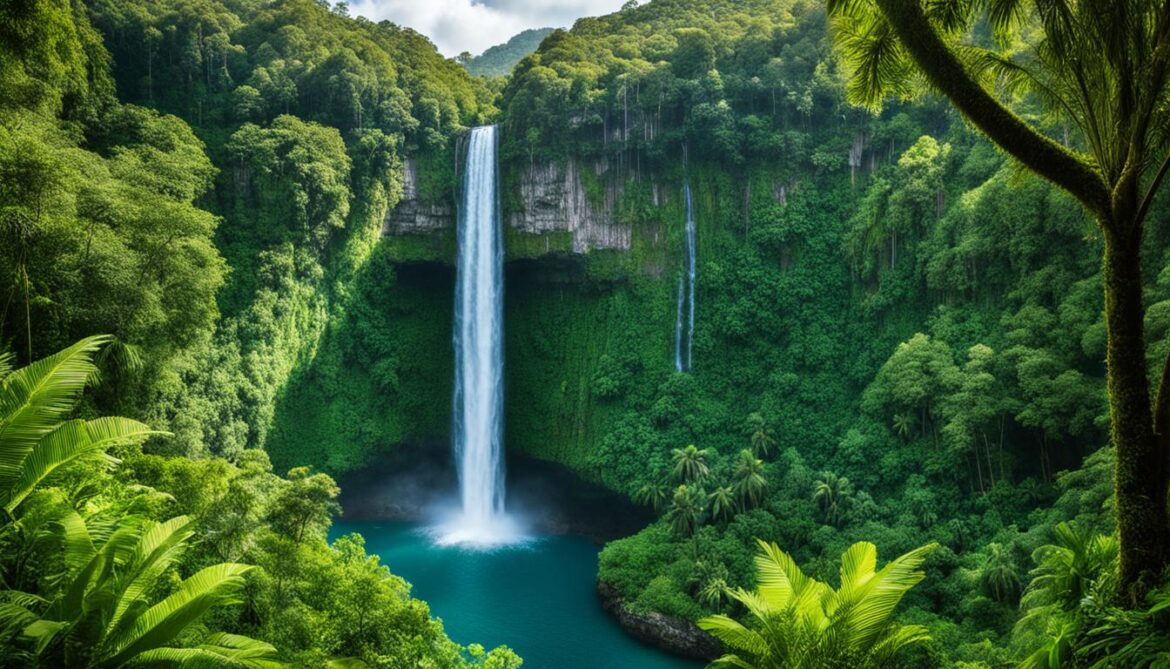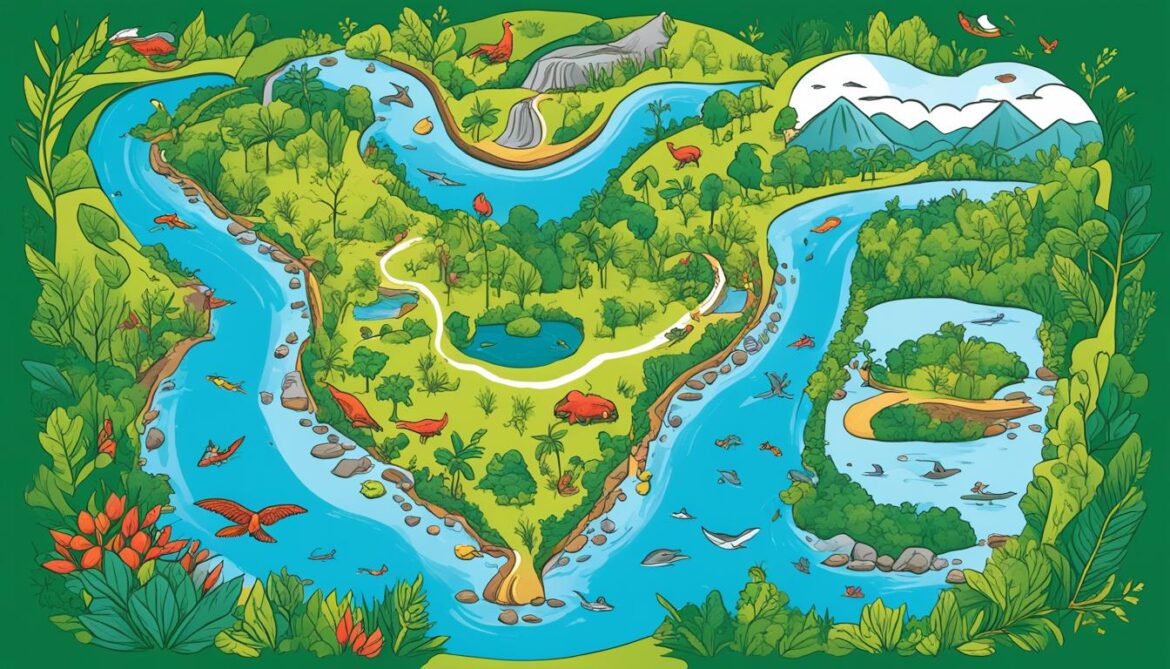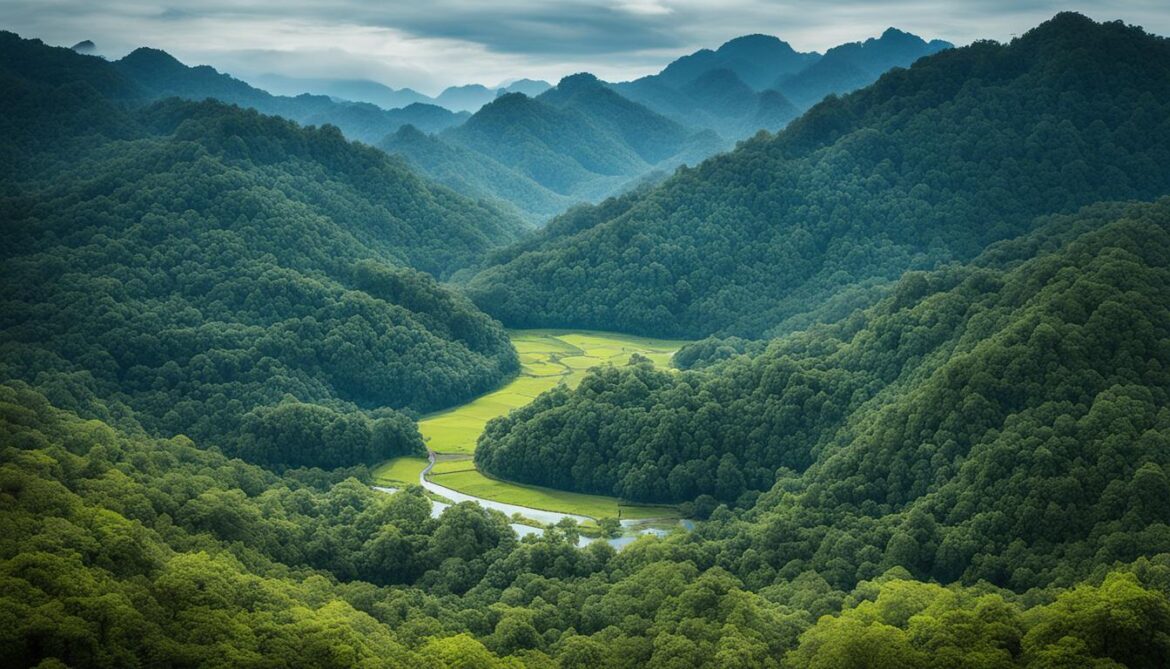Did you know that Malaysia is home to several Sacred Natural Sites that contribute to the country’s vibrant biodiversity and serve as hotspots for ecotourism and wildlife preservation?
The concept of Sacred Natural Sites and their importance in preserving biodiversity within cultural landscapes occupied by local communities is gaining recognition. These sites, which have been protected and managed by indigenous cultures for generations, play a crucial role in biodiversity conservation, sustainable development, and the preservation of indigenous knowledge and cultures.
Key Takeaways:
- Malaysia’s Sacred Natural Sites contribute to the preservation of biodiversity and indigenous cultures.
- These sites serve as ecotourism hotspots and promote sustainable development.
- Indigenous communities have intimate knowledge of these sites and play a vital role in their management.
- Biodiversity hotspots within Malaysia’s Sacred Natural Sites support rare and endangered species.
- Collaborative conservation efforts and a strong policy framework are essential for the long-term preservation of these sites.
The Importance of Sacred Natural Sites in Malaysia
Sacred Natural Sites in Malaysia play a vital role in preserving biodiversity and are of immense significance to indigenous cultures. These sites provide a unique opportunity to protect and conserve Malaysia’s diverse ecosystems while honoring the cultural and spiritual connections that indigenous communities have with the land. Through the conservation of Sacred Natural Sites, Malaysia can safeguard its rich biodiversity and ensure the survival of traditional practices, beliefs, and ways of life.
Managed by indigenous communities who possess extensive knowledge of the land and its resources, these Sacred Natural Sites serve as important hubs for conservation and environmental protection. By preserving these sites, Malaysia can maintain the delicate balance between conservation and cultural heritage.
These Sacred Natural Sites are not only essential for the protection of biodiversity but also contribute to the overall well-being and sustainability of indigenous communities. These sites are deeply rooted in the cultural and spiritual identity of indigenous peoples, and preserving them helps maintain the social fabric and traditional knowledge systems of these communities.
Preserving Sacred Natural Sites ensures the continuity of indigenous cultural practices and reinforces the connection between people and nature, fostering a deep respect for the environment and the need for sustainable resource management.
Moreover, the conservation of Sacred Natural Sites can provide opportunities for ecotourism, promoting economic growth while maintaining the ecological integrity of these areas. This sustainable form of tourism can generate income for indigenous communities and raise awareness about the importance of environmental protection and the preservation of indigenous cultures.
“Sacred Natural Sites in Malaysia embody the harmonious relationship between people and nature, and their preservation is crucial for the well-being of both.” – Dr. Lim Li Ching, Conservation Biologist
By recognizing the importance of Sacred Natural Sites and supporting the collaboration between government agencies, organizations, and indigenous communities, Malaysia can ensure the long-term protection of these natural and cultural treasures. The preservation of Sacred Natural Sites is a testament to Malaysia’s commitment to biodiversity conservation, cultural preservation, and sustainable development.
Next, let’s explore the biodiversity hotspots that are found within Malaysia’s Sacred Natural Sites, shedding light on the incredible species richness and unique ecosystems that make these areas so special.
https://www.youtube.com/watch?v=AC6xA7xdsrw
Biodiversity Hotspots in Malaysia’s Sacred Natural Sites
Malaysia’s Sacred Natural Sites are renowned for their remarkable biodiversity, establishing them as significant hotspots for wildlife preservation. These sites serve as habitats for a wide range of species, including those that are rare and endangered. One prominent example is the Belum-Temengor Forest Complex, a Sacred Natural Site located in Malaysia. This complex stands as one of the few remaining untouched rainforests in Asia and supports a diverse array of plant and animal species. Notably, it provides a sanctuary for critically endangered species such as the Malayan tiger and Asian elephant.

Biodiversity in the Belum-Temengor Forest Complex
| Species |
Status |
| Malayan tiger |
Critically endangered |
| Asian elephant |
Endangered |
| Sumatran rhinoceros |
Critically endangered |
| Malayan tapir |
Endangered |
| Orangutan |
Endangered |
| Clouded leopard |
Vulnerable |
The Belum-Temengor Forest Complex is just one example of the abundance of biodiversity found within Malaysia’s Sacred Natural Sites. These sites play a crucial role in protecting and preserving the country’s natural heritage, fostering a harmonious coexistence between humans and wildlife.
Sustainable Development and Ecotourism in Malaysia’s Sacred Natural Sites
Malaysia’s Sacred Natural Sites offer more than just biodiversity conservation opportunities; they also play a vital role in sustainable development. These sites provide a platform for ecotourism, fostering economic growth while prioritizing environmental protection and the well-being of local communities. By adhering to sustainable tourism practices, these areas generate income for indigenous communities and raise awareness about the significance of preserving these sacred sites.
Ecotourism in Malaysia’s Sacred Natural Sites not only showcases the country’s stunning biodiversity but also supports the livelihoods of local communities. Tourists have the opportunity to experience the beauty of these sites while learning about the indigenous cultures and traditions that have preserved them for generations. This immersive experience helps visitors develop a deeper appreciation for nature and fosters a sense of responsibility towards its protection.
Through sustainable development and ecotourism, Malaysia’s Sacred Natural Sites become catalysts for change. The revenue generated from tourism activities can be reinvested in conservation efforts, such as habitat restoration and the implementation of sustainable practices. Additionally, the engagement of local communities in tourism activities empowers them economically, creating a vested interest in preserving these invaluable sites for future generations.
Sustainable tourism practices in Malaysia’s Sacred Natural Sites not only benefit the environment but also have positive social and economic impacts. By preserving these sites, we ensure the conservation of biodiversity and the rich cultural heritage associated with them. This integrated approach to development ensures that future generations can experience the natural wonders of Malaysia while supporting the sustainable growth of local communities.
As visitors explore Malaysia’s Sacred Natural Sites, they are encouraged to respect the cultural sensitivities of indigenous communities and adhere to responsible tourism practices. By following these guidelines, tourists become agents of change, contributing to the long-term sustainability of these sites and fostering a sense of global environmental stewardship.
In conclusion, sustainable development and ecotourism go hand in hand at Malaysia’s Sacred Natural Sites. By embracing eco-friendly practices, these sites not only preserve biodiversity but also drive economic growth and empower local communities. Through responsible tourism, we can ensure the long-term sustainability of these sites, protecting the unique cultural and natural heritage they embody.
Indigenous Cultures and Traditional Knowledge in Malaysia’s Sacred Natural Sites
Indigenous cultures in Malaysia have a deep connection to the land and have developed unique traditional practices and knowledge systems related to the management and conservation of Sacred Natural Sites. These communities hold a wealth of traditional knowledge that provides invaluable insights into the intricate relationships between humans and nature.
Through their close bond with the natural environment, indigenous cultures have gained a deep understanding of the delicate balance and interdependencies within ecosystems. Their traditional knowledge encompasses sustainable practices for resource management, ethical hunting techniques, and medicinal plant usage. The wisdom passed down through generations has played a vital role in maintaining the delicate biodiversity found within Malaysia’s Sacred Natural Sites.
By recognizing and supporting indigenous cultures, Malaysia not only preserves the intangible heritage of these communities but also safeguards its rich biodiversity. Upholding the traditional knowledge held by indigenous peoples is key to informing conservation efforts, ensuring that sustainable practices are implemented to protect Malaysia’s Sacred Natural Sites and their unique ecosystems.
“The traditional knowledge held by indigenous communities is a treasure trove of insights into the relationship between people and the natural world. This knowledge can greatly contribute to effective conservation strategies that maintain the delicate balance between environmental protection and sustainable development.” – Conservation Expert
Moreover, the inclusion and empowerment of indigenous communities in decision-making processes have proven to be effective strategies in biodiversity conservation. By involving local communities, their deep-rooted respect and understanding of the land can guide sustainable management practices, leading to more successful conservation outcomes.
The traditional knowledge held by indigenous cultures in Malaysia’s Sacred Natural Sites not only contributes to the preservation of biodiversity but also has the potential to inspire innovative conservation solutions that harmonize with cultural values. Recognizing the invaluable contributions of indigenous knowledge systems is crucial for the long-term preservation of Malaysia’s rich natural heritage.
Preserving Biodiversity through Indigenous Knowledge
Indigenous knowledge has been instrumental in maintaining the fragile balance of Malaysia’s Sacred Natural Sites. It fosters a holistic approach to conservation that embraces both ecological and cultural considerations. Through their traditional practices, indigenous communities demonstrate the importance of sustainable living and serve as custodians of the natural world.
By drawing on the wisdom of indigenous cultures and integrating their traditional knowledge into conservation strategies, Malaysia can ensure the survival of its diverse ecosystems and preserve the cultural identity of its indigenous peoples.

| Indigenous Practices |
Conservation Impact |
| Selective logging techniques |
Preserves forest structure and limits ecological impact |
| Traditional farming methods |
Promotes biodiversity and maintains soil fertility |
| Community-led conservation efforts |
Ensures local participation and commitment to long-term protection |
| Traditional resource management |
Prevents overexploitation and maintains sustainable resource use |
These examples highlight how indigenous cultures’ traditional knowledge can inform conservation practices that not only protect biodiversity but also respect cultural values. By engaging with indigenous communities and acknowledging their invaluable contributions, Malaysia can pave the way for a more inclusive and sustainable approach to biodiversity conservation.
Conservation Initiatives for Malaysia’s Sacred Natural Sites
Recognizing the importance of Malaysia’s Sacred Natural Sites, various conservation initiatives have been implemented to protect and preserve these areas. Through partnerships between government agencies, NGOs, and local communities, these initiatives aim to develop sustainable management plans, enforce protective measures, and raise awareness about the ecological and cultural significance of these sites.
One notable conservation initiative is the collaborative effort between the Malaysian Department of Environment, local Indigenous communities, and the World Wildlife Fund (WWF). Together, they have established conservation programs focused on safeguarding the Sacred Natural Sites, promoting environmental protection, and preserving the unique biodiversity found within these areas. By combining scientific expertise with traditional knowledge and practices, these initiatives seek to balance conservation efforts with the needs and aspirations of local communities.
“Our conservation initiatives prioritize community engagement and empowerment. By involving local communities in decision-making processes and capacity-building programs, we strive to create a sense of ownership and responsibility. This not only strengthens the effectiveness of conservation efforts but also ensures the sustainability and long-term success of these initiatives.” – Dr. Liyaan bin Rahim, Conservation Director at WWF Malaysia
An essential aspect of these conservation initiatives is the establishment of protected areas and the implementation of measures to control human activities that may have detrimental impacts on the fragile ecosystems within Sacred Natural Sites. Through comprehensive zoning plans, strict monitoring and enforcement, and public education campaigns, these initiatives aim to strike a balance between sustainable resource utilization and environmental preservation.
Furthermore, these initiatives focus on enhancing the capacity of local communities to manage and conserve the Sacred Natural Sites effectively. Training programs, workshops, and knowledge-sharing platforms provide opportunities for community members to develop skills in sustainable land and resource management. By empowering local stakeholders, these conservation initiatives ensure the meaningful participation and active involvement of communities in preserving their cultural and natural heritage.

In addition to government and NGO-led initiatives, these conservation efforts often benefit from international collaborations and partnerships. Academic institutions, research organizations, and conservation networks contribute scientific expertise, technical support, and financial resources to strengthen the impact and outreach of these initiatives.
The Impacts of Conservation Initiatives
Thanks to these conservation initiatives, substantial progress has been made in protecting and preserving Malaysia’s Sacred Natural Sites. The collaborative efforts have resulted in enhanced biodiversity conservation, improved ecological resilience, and the promotion of sustainable practices as a model for other regions facing similar challenges.
| Conservation Initiative |
Impact |
| Establishment of protected areas |
Preservation of critical habitats and ecosystems |
| Community participation |
Ownership and stewardship of Sacred Natural Sites |
| Public education campaigns |
Increased awareness of environmental importance |
| Scientific research and monitoring |
Enhanced knowledge for evidence-based conservation |
By implementing these conservation initiatives, Malaysia is not only protecting its Sacred Natural Sites and their biodiversity but also safeguarding the cultural heritage and identity of its Indigenous communities. These initiatives contribute to the global effort of environmental protection and ensure a sustainable future for both nature and people.
Policy and Legal Framework for Sacred Natural Sites in Malaysia
While the concept of Sacred Natural Sites is not widely acknowledged in policies and laws, there are provisions in the national context of Malaysia that support or tolerate these sites. Efforts are underway to strengthen the policy and legal framework for the recognition and protection of Sacred Natural Sites, ensuring their continued conservation and preservation. These initiatives aim to integrate the cultural and ecological values of these sites into national strategies for biodiversity conservation and sustainable development.
Malaysia Sacred Natural Sites and Biodiversity are an invaluable part of the country’s natural heritage. To secure their existence and protect their cultural and ecological significance, the government is working towards establishing a comprehensive policy framework and legal protection for these sites. By doing so, they aim to preserve Malaysia’s rich biodiversity and ensure sustainable development for future generations.
“The recognition and protection of Sacred Natural Sites in Malaysia play a vital role in preserving the country’s unique biodiversity and cultural heritage. Strengthening the policy and legal framework is essential in safeguarding these sites and integrating them into broader conservation strategies.”
– Environmental Expert
Malaysia’s commitment to conservation is demonstrated through ongoing efforts to enhance and integrate the policy and legal framework for Sacred Natural Sites. By recognizing their cultural and ecological importance, the government aims to ensure their long-term preservation.
Current Policy and Legal Provisions
The policy and legal provisions pertaining to Sacred Natural Sites in Malaysia are still evolving and are not widely encompassing. However, there are initiatives and provisions that recognize the importance of these sites and offer a level of protection. For example:
- Acknowledgment of the cultural and spiritual significance of certain areas by the authorities.
- Support and encouragement of community stewardship and traditional practices.
- Recognition of the value of indigenous knowledge and expertise in managing Sacred Natural Sites.
- Collaborative efforts between government agencies, NGOs, and indigenous communities to protect and conserve these sites.
While these provisions acknowledge the importance of Sacred Natural Sites, a comprehensive and unified policy framework is still needed for consistent protection and management.
The Path to Strengthening the Framework
Recognizing the need for a stronger policy and legal framework, Malaysia is actively working towards its realization. Efforts include:
- Engaging with indigenous communities and stakeholders to identify areas in need of protection and conservation.
- Collaborating with international organizations and experts to learn from global best practices and incorporate them into Malaysian policies.
- Conducting research and studies to assess the ecological and cultural significance of Sacred Natural Sites.
- Developing guidelines for the management, conservation, and sustainable use of these sites.
By strengthening the policy and legal framework, Malaysia aims to enhance the recognition, protection, and management of Sacred Natural Sites, ensuring their preservation for future generations.
It is crucial to strike a balance between conservation efforts and the rights and interests of local communities. The government is committed to promoting inclusivity and empowering indigenous communities in decision-making processes regarding the management and protection of Sacred Natural Sites.
The envisioned policy and legal framework will facilitate the integration of cultural and ecological values, aligning them with national strategies for biodiversity conservation and sustainable development.
The Way Forward
The journey towards a comprehensive policy and legal framework for Sacred Natural Sites in Malaysia is ongoing. It requires the commitment and collaboration of various stakeholders, including indigenous communities, governmental bodies, NGOs, and international partners. Together, these efforts aim to:
- Ensure the recognition and protection of Sacred Natural Sites as crucial components of Malaysia’s natural and cultural heritage.
- Uphold the rights and interests of local communities and indigenous peoples in the management and decision-making processes of these sites.
- Promote sustainable development practices that respect the ecological integrity and cultural values of Sacred Natural Sites.
- Integrate Sacred Natural Sites into national strategies for biodiversity conservation and sustainable development.
Through a strengthened policy and legal framework, Malaysia will be better equipped to protect and preserve its Sacred Natural Sites, safeguarding its unique biodiversity and cultural heritage for generations to come.

Challenges and Opportunities for Malaysia’s Sacred Natural Sites
Malaysia’s Sacred Natural Sites play a crucial role in the conservation of biodiversity, but they face several challenges that threaten their sustainability. These challenges include encroachment, land degradation, climate change, and the need for capacity building and stakeholder engagement. Addressing these challenges is vital to ensuring the long-term protection of these invaluable sites and the biodiversity they support.
Encroachment poses a significant threat to Malaysia’s Sacred Natural Sites, as human activities encroach upon these areas and disturb the delicate ecosystems. Increased urbanization, agricultural expansion, and infrastructure development often lead to habitat destruction, fragmentation, and the loss of biodiversity. Strict enforcement of protected area boundaries, increased public awareness, and the involvement of local communities in site management are essential to mitigating the impact of encroachment.
Land degradation is another pressing challenge faced by Sacred Natural Sites in Malaysia. Unsustainable land-use practices, such as deforestation, illegal logging, and improper waste management, contribute to soil erosion, loss of habitat, and degradation of water resources. Implementing sustainable land management practices, promoting reforestation efforts, and educating local communities about the importance of ecosystem conservation are key to addressing land degradation and restoring the health of these sites.
Climate change poses a significant threat to Malaysia’s Sacred Natural Sites, as rising temperatures, changing precipitation patterns, and extreme weather events impact the delicate balance of ecosystems. These changes disrupt plant and animal species’ habitats, threaten their survival, and disrupt the intricate relationships within these ecosystems. Integrating climate change adaptation strategies into site management plans, promoting sustainable practices to reduce carbon emissions, and enhancing ecosystem resilience are essential in mitigating the impacts of climate change on these sites.
The need for capacity building and stakeholder engagement is crucial in ensuring the effective conservation of Malaysia’s Sacred Natural Sites. Building the capacity of local communities and relevant stakeholders in site management, biodiversity monitoring, and sustainable tourism practices empowers them to actively participate in the protection and preservation of these sites. Engaging indigenous communities, academia, government agencies, NGOs, and local businesses in collaborative efforts fosters a sense of ownership and shared responsibility, ensuring the long-term sustainability of these sites.
While these challenges are significant, there are also opportunities to address them and enhance the conservation of Malaysia’s Sacred Natural Sites. Collaboration among stakeholders, including researchers, policymakers, communities, and conservation organizations, can provide innovative solutions to these challenges. Research efforts can provide scientific evidence to support conservation initiatives, guide management decisions, and inform policy development. By empowering local communities through capacity building, supporting sustainable livelihoods, and promoting ecotourism, Malaysia can capitalize on the economic, social, and ecological opportunities that arise from the conservation of these sites.

In conclusion, addressing the challenges faced by Malaysia’s Sacred Natural Sites is essential for their long-term conservation and the preservation of the biodiversity they harbor. By mitigating encroachment, combating land degradation, adapting to climate change, and fostering stakeholder engagement, Malaysia can protect these sites while capitalizing on the opportunities for collaborative research, community empowerment, and sustainable development. The preservation of Malaysia’s Sacred Natural Sites not only safeguards its natural and cultural heritage but also contributes to global efforts in biodiversity conservation and sustainable environmental stewardship.
Future Prospects for Malaysia’s Sacred Natural Sites
The future prospects for Malaysia’s Sacred Natural Sites are filled with hope and promise. There is a growing recognition of the ecological and cultural importance of these sites, spurring continued conservation efforts and collaborative initiatives for their long-term survival.
By preserving and protecting these Sacred Natural Sites, Malaysia can contribute significantly to global endeavors aimed at safeguarding the planet’s natural and cultural heritage.

Conservation Efforts
Conservation efforts play a vital role in securing the future of Malaysia’s Sacred Natural Sites. These efforts involve the implementation of sustainable management practices, the establishment of protected areas, and the enforcement of protective measures.
Collaborative initiatives between government agencies, NGOs, and local communities are key to the success of conservation endeavors. Together, they work towards preserving the unique biodiversity and cultural heritage housed within these sacred landscapes.
Community Involvement
Community involvement is essential for the long-term survival of Malaysia’s Sacred Natural Sites. Engaging local communities and indigenous groups in conservation efforts not only ensures their active participation but also fosters a sense of ownership and stewardship.
Empowering communities through education, capacity building, and sustainable livelihood opportunities strengthens the bond between people and land. By valuing and respecting the traditional knowledge and practices of these communities, Malaysia can create a sustainable future for its Sacred Natural Sites.
The Way Forward
Looking ahead, Malaysia has a unique opportunity to lead the way in sacred site conservation. By leveraging international cooperation, research, and innovation, Malaysia can establish itself as a role model for other nations facing similar challenges.
Strategic planning, policy development, and strengthened legal frameworks will be crucial in ensuring the continued preservation of these sites. By embracing sustainable practices and promoting environmental stewardship, Malaysia can secure a brighter future for its Sacred Natural Sites and the rich biodiversity they harbor.
“The preservation of Malaysia’s Sacred Natural Sites is not just a responsibility; it is our legacy for future generations.” – Dr. Nurul Huda Ahmad, Environmental Scientist
| Future Prospects |
Conservation Efforts |
Community Involvement |
| Recognition of ecological and cultural importance |
Sustainable management practices |
Engaging local communities |
| Continued conservation efforts |
Establishment of protected areas |
Empowering through education |
| Collaborative initiatives |
Enforcement of protective measures |
Capacity building and livelihood opportunities |
| Contribution to global preservation |
Partnerships between government, NGOs, and communities |
Valuing traditional knowledge and practices |
Collaborative Efforts for the Conservation of Malaysia’s Sacred Natural Sites
Effective conservation of Malaysia’s Sacred Natural Sites requires collaboration between government agencies, NGOs, indigenous communities, and other stakeholders. By working together, these diverse groups can leverage their collective knowledge and expertise to develop sustainable management practices and achieve common goals of biodiversity conservation, cultural preservation, and sustainable development.
“Collaboration is the key to success in conserving Malaysia’s Sacred Natural Sites. By pooling our resources and sharing our experiences, we can make a greater impact on the preservation of our natural heritage and the promotion of sustainable practices.”
Collaborative initiatives for the conservation of Malaysia’s Sacred Natural Sites involve fostering strong partnerships and maintaining a shared commitment to protecting and preserving these valuable areas. Through these initiatives, stakeholders can exchange insights, strategies, and best practices, enabling the development of effective conservation plans and actions.
Examples of Collaborative Efforts:
- Knowledge Sharing and Capacity Building: Government agencies, NGOs, and indigenous communities collaborate to exchange traditional knowledge, scientific research, and practical skills related to the conservation of Sacred Natural Sites. Workshops, training programs, and educational campaigns are organized to enhance the capacity of local communities and stakeholders involved.
- Sustainable Management Planning: Collaborative efforts focus on developing and implementing sustainable management plans for Malaysia’s Sacred Natural Sites. These plans consider ecological conservation, cultural preservation, and the economic well-being of local communities. Through careful planning and consultation, stakeholders can ensure the long-term sustainability and integrity of these areas.
- Enforcement and Monitoring: Collaborative initiatives involve the joint efforts of government agencies, NGOs, and local communities to enforce protective measures and monitor the condition of Malaysia’s Sacred Natural Sites. Regular monitoring and enforcement activities help identify potential threats and take proactive measures to mitigate them.

Through collaborative initiatives, Malaysia can tap into the collective wisdom and resources of various stakeholders, fostering a holistic and inclusive approach to the conservation of Sacred Natural Sites. By pooling their efforts, these collaborative endeavors contribute to the ongoing protection and preservation of Malaysia’s precious natural and cultural heritage.
Conclusion
Malaysia’s Sacred Natural Sites, with their rich biodiversity and deep cultural significance, play a critical role in the conservation of our planet’s natural heritage. These invaluable treasures not only protect diverse plant and animal species but also preserve the traditions and knowledge of indigenous communities.
Through collaborative efforts and conservation initiatives, Malaysia has become a model for other countries seeking to strike a balance between environmental protection, cultural preservation, and sustainable development. By recognizing the importance of these sites and working together to safeguard them, Malaysia is making a significant contribution to global conservation efforts.
The preservation of Malaysia’s Sacred Natural Sites is essential not only for the country but also for the world. By prioritizing the protection of biodiversity and supporting the local communities that sustain these sites, we ensure a more sustainable and resilient future for all.
FAQ
What are Sacred Natural Sites and why are they important in Malaysia?
Sacred Natural Sites are areas protected and managed by indigenous cultures for generations. They play a crucial role in biodiversity conservation, sustainable development, and the preservation of indigenous knowledge and cultures in Malaysia.
How do Sacred Natural Sites contribute to biodiversity preservation in Malaysia?
Sacred Natural Sites in Malaysia provide a unique opportunity to protect and conserve biodiversity, as they are managed by indigenous communities who have intimate knowledge of the land and its resources.
What makes Malaysia’s Sacred Natural Sites biodiversity hotspots?
Malaysia’s Sacred Natural Sites are known for their incredible biodiversity, providing a home to diverse species, including rare and endangered ones.
How do Malaysia’s Sacred Natural Sites contribute to sustainable development?
These sites provide opportunities for ecotourism, promoting economic growth while ensuring environmental protection and the well-being of local communities.
Why is indigenous culture and traditional knowledge important in the management of Sacred Natural Sites in Malaysia?
Indigenous cultures in Malaysia have developed unique traditional practices and knowledge systems related to the conservation of Sacred Natural Sites, which are invaluable in understanding the relationships between humans and nature.
What conservation initiatives are in place for Malaysia’s Sacred Natural Sites?
Various conservation initiatives involving government agencies, NGOs, and local communities have been implemented to protect and preserve these sites.
What is the policy and legal framework for the recognition and protection of Sacred Natural Sites in Malaysia?
Although not widely acknowledged in policies and laws, there are provisions in the national context of Malaysia that support the recognition and protection of Sacred Natural Sites.
What are the challenges and opportunities for the conservation of Malaysia’s Sacred Natural Sites?
Challenges include encroachment, land degradation, climate change, and the need for capacity building. However, there are also opportunities for collaboration, research, and community empowerment to address these challenges.
What are the future prospects for Malaysia’s Sacred Natural Sites?
The future prospects are promising, with growing recognition of their ecological and cultural importance. Continued conservation efforts, collaborative initiatives, and community involvement are key for their long-term survival.
What collaborative efforts are essential for the conservation of Malaysia’s Sacred Natural Sites?
Collaboration between government agencies, NGOs, indigenous communities, and other stakeholders is essential for effective conservation, involving sharing knowledge, developing sustainable management practices, and working towards common goals.
What is the conclusion regarding Malaysia’s Sacred Natural Sites and biodiversity conservation?
Malaysia’s Sacred Natural Sites are invaluable treasures that contribute to biodiversity protection, indigenous cultural preservation, and sustainable development. Continued conservation efforts serve as a model for other countries and contribute to global preservation efforts.

























Post comments (0)